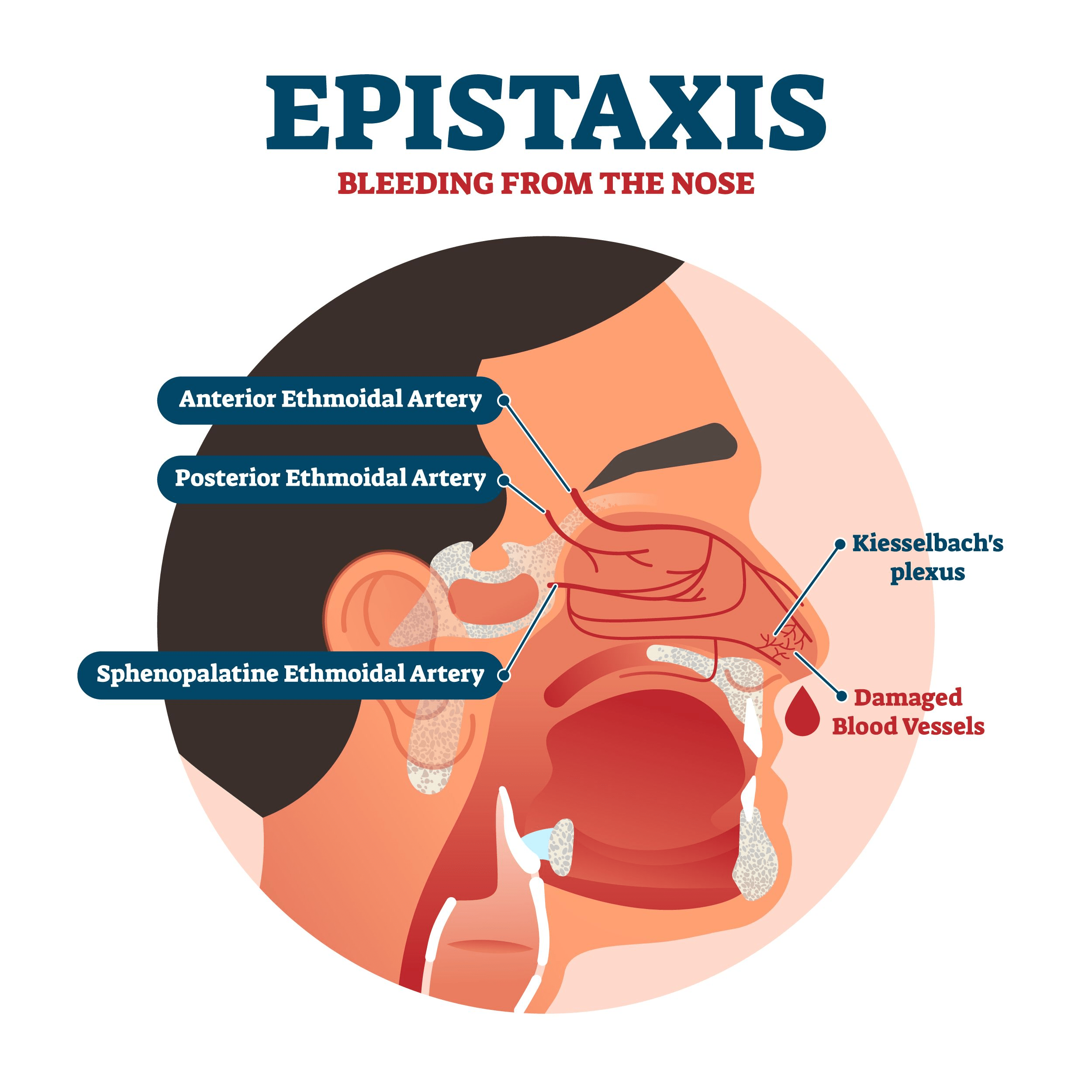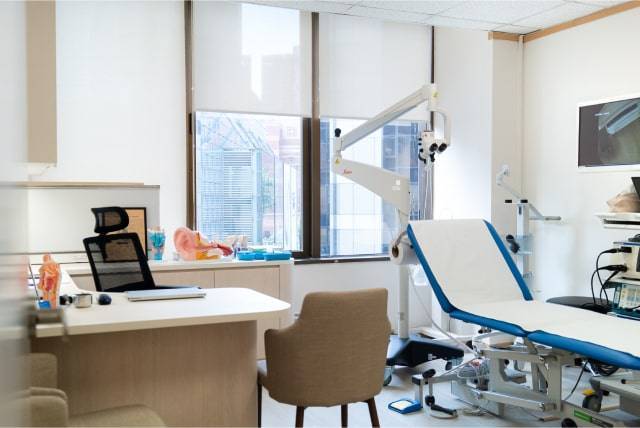Epistaxis: Understanding, Management, and Prevention

Introduction
Epistaxis, commonly known as a nosebleed, is a frequent medical concern that affects a wide demographic, from the young to the elderly. While often benign, the sight of blood can be alarming, making it crucial to understand both the management and underlying causes of epistaxis. This article aims to demystify nosebleeds, providing insights into their causes, when to seek medical attention from a specialist, and how to prevent them effectively.
Understanding Epistaxis

Epistaxis is characterised by bleeding from the nasal cavity or nasopharynx, the area inside the nose extending to the back of the throat. It’s a symptom rather than a disease, indicating irritation, trauma, or an underlying condition affecting the nasal membranes.
Anatomy of the Nose
The nasal cavity, richly supplied with blood vessels, is particularly prone to bleeding when these vessels are damaged. The Kiesselbach’s plexus, a vascular network in the front part of the septum, is the most common site for anterior nosebleeds, which constitute the majority of epistaxis cases.
Types of Epistaxis
Epistaxis is categorised into anterior and posterior bleeds. Anterior nosebleeds, which originate from the front of the nose, are more common and often less severe. Posterior nosebleeds originate from deeper within the nasal cavity and can be more profuse, often requiring medical intervention.
Causes and Risk Factors
Common Causes
The causes of epistaxis range from simple to complex, including dry air, nasal trauma, infections, allergies, and the use of certain medications like anticoagulants. High blood pressure and alcohol use can also exacerbate the risk of nosebleeds.
Risk Factors
Vulnerable groups include children, due to their tendency for nasal exploration, and the elderly, who may have more fragile blood vessels or be on medications that affect bleeding. Environmental factors like dry climates and certain occupational hazards can also increase risk.
Symptoms and When to Seek Medical Attention

Recognising Symptoms
While the primary symptom is bleeding from one or both nostrils, accompanying symptoms like prolonged bleeding, frequent recurrence, or bleeding accompanied by headache or fever can signal a more serious condition.
When to Seek Help from an Ear Nose and Throat Specialist
Immediate medical attention is warranted if the bleeding does not stop after 20 minutes of direct pressure, if it’s the result of a head injury, or if it occurs in patients with high blood pressure (hypertension) or a bleeding disorder.
Diagnosis
A detailed medical history and physical examination are pivotal in assessing epistaxis. At Aglow ENT Centre, our ENT specialist and Medical Director, Dr Ker Liang, fill focus on the duration, frequency and severity of nosebleeds, as well as any contributing factors like trauma or medication use. For recurrent cases, further investigation to identify underlying causes is necessary.
Management & Treatment
For at-home care, remain calm and adopt the strategies for controlling an active nosebleed, which include sitting upright, leaning forward slightly, and pinching the soft part of the nose. Avoid lying flat or tilting the head back, as this can result in blood running down the throat. If bleeding persists after 20 minutes despite initial measures, seek medical attention.
Our ENT doctor will usually recommend non-invasive medical intervention, such as the prescription of medication (e.g. topical vasoconstrictors) and nasal packing (inserting gauze or sponge-like materials into the nostrils to apply pressure and stop bleeding).
For severe cases, one or more of the following surgical interventions to correct anatomical contributors to epistaxis may be necessary.
Endoscopic Sphenopalatine Artery Ligation: Effective for Controlling Intractable Posterior Epistaxis
Endoscopic sphenopalatine artery ligation involves tying off the artery that supplies blood to the nose’s back area. This surgical treatment effectively stops severe nosebleeds that originate from the back of the nose.
Direct Cauterisation: A Surgical Technique for Posterior Epistaxis Management Using Endoscopic Methods
Direct cauterisation refers to using heat or chemicals to seal off bleeding blood vessels. This surgical technique is specifically used through endoscopic methods to treat nosebleeds from the back of the nose.
Transnasal Endoscopic Sphenopalatine/Posterior Nasal Artery Ligation: Utilised in Endoscopic Management of Posterior Epistaxis
Transnasal endoscopic sphenopalatine/posterior nasal artery ligation involves tying off or cauterising the blood vessels at the back of the nose using an endoscope. This approach is part of endoscopic management for nosebleeds originating from the back of the nose.
Preventive Measures
Preventing nosebleeds involves maintaining nasal moisture through the use of humidifiers and nasal saline sprays, avoiding nasal irritants, and gentle nose blowing. Keeping fingernails short and discouraging nose picking, especially in children, can also reduce the risk.
Conclusion
Epistaxis, while commonly benign, requires proper understanding and management to prevent and address effectively. Recognising when a nosebleed is a sign of something more serious is crucial, as is knowing how to respond when one occurs. By staying informed and prepared, individuals can minimise the impact of epistaxis on their daily lives, ensuring swift and effective resolution when nosebleeds occur.
When should you see an ENT specialist in Singapore?
Please consult an ENT specialist if you are suffering from any ear, nose, or throat symptoms. It is also advisable to visit an ENT doctor if you experience persistent mouth breathing due to a chronic blocked nose or encounter snoring issues.
Dr Ker Liang sees adults and children for general ENT conditions and provides comprehensive management in a broad range of Ear, Nose, and Throat, as well as Head and Neck conditions. She has a special interest in treating throat and voice conditions, including persistent sore throat, voice issues, snoring, and Obstructive Sleep Apnoea (OSA).
Medical Teaching
Assistant Professor Ker Liang has a passion for teaching and is an Assistant Professor with NUS Yong Loo Lin School of Medicine (YLLSOM). As the NUS-NUH Otolaryngology Department Undergraduate Medical Director, Dr Ker Liang supervises the training of medical students from YLLSOM, NUS. She is actively involved
in the training of postgraduate junior doctors and residents in the Head and Neck Surgery department. She was conferred with an Undergraduate Teaching Award by the National University Health System in 2016 for her outstanding efforts as an Otolaryngology educator.
Medical Teaching
Assistant Professor Ker Liang has a passion for teaching and is an Assistant Professor with NUS Yong Loo Lin School of Medicine (YLLSOM). As the NUS-NUH Otolaryngology Department Undergraduate Medical Director, Dr Ker Liang supervises the training of medical students from YLLSOM, NUS. She is actively involved
in the training of postgraduate junior doctors and residents in the Head and Neck Surgery department. She was conferred with an Undergraduate Teaching Award by the National University Health System in 2016 for her outstanding efforts as an Otolaryngology educator.
Lorem ipsum dolor sit amet, consectetur adipiscing
Lorem ipsum dolor sit amet, consectetur adipiscing elit. Ut elit tellus, luctus nec ullamcorper mattis, pulvinar dapibus leo. Lorem ipsum dolor sit amet, consectetur adipiscing elit. Ut elit tellus, luctus nec ullamcorper mattis, pulvinar dapibus leo.
Lorem ipsum dolor sit amet, consectetur adipiscing
Lorem ipsum dolor sit amet, consectetur adipiscing elit. Ut elit tellus, luctus nec ullamcorper mattis, pulvinar dapibus leo. Lorem ipsum dolor sit amet, consectetur adipiscing elit. Ut elit tellus, luctus nec ullamcorper mattis, pulvinar dapibus leo.
Lorem ipsum dolor sit amet, consectetur adipiscing
Lorem ipsum dolor sit amet, consectetur adipiscing elit. Ut elit tellus, luctus nec ullamcorper mattis, pulvinar dapibus leo. Lorem ipsum dolor sit amet, consectetur adipiscing elit. Ut elit tellus, luctus nec ullamcorper mattis, pulvinar dapibus leo.
Lorem ipsum dolor sit amet, consectetur adipiscing
Lorem ipsum dolor sit amet, consectetur adipiscing elit. Ut elit tellus, luctus nec ullamcorper mattis, pulvinar dapibus leo. Lorem ipsum dolor sit amet, consectetur adipiscing elit. Ut elit tellus, luctus nec ullamcorper mattis, pulvinar dapibus leo.
Lorem ipsum dolor sit amet, consectetur adipiscing
Lorem ipsum dolor sit amet, consectetur adipiscing elit. Ut elit tellus, luctus nec ullamcorper mattis, pulvinar dapibus leo. Lorem ipsum dolor sit amet, consectetur adipiscing elit. Ut elit tellus, luctus nec ullamcorper mattis, pulvinar dapibus leo.



